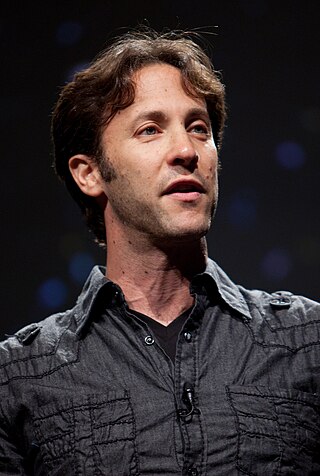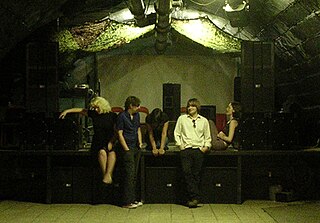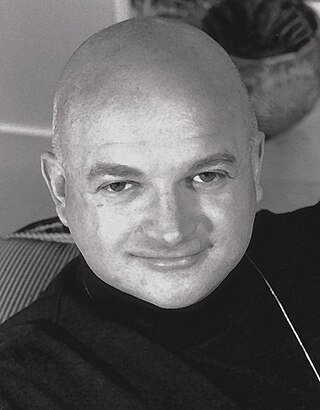The clavier à lumières, or tastiera per luce, as it appears in the score, was a musical instrument invented by Alexander Scriabin for use in his work Prometheus: Poem of Fire. Only one version of this instrument was constructed, for the performance of Prometheus: Poem of Fire in New York City in 1915. The instrument was supposed to be a keyboard, with notes corresponding to colors as given by Scriabin's synesthetic system, specified in the score. However, numerous synesthesia researchers have cast doubt on the claim that Scriabin was a synesthete.

The Man Who Tasted Shapes is a book by neurologist Richard Cytowic about synesthesia.

James Wannerton; is an English IT professional, artist and writer. He experiences sound to taste synesthesia, including lexical-gustatory synesthesia; i.e. he can "taste" sounds, including words or word sounds.

David Eagleman is an American neuroscientist, author, and science communicator. He teaches neuroscience at Stanford University and is CEO and co-founder of Neosensory, a company that develops devices for sensory substitution. He also directs the non-profit Center for Science and Law, which seeks to align the legal system with modern neuroscience and is Chief Science Officer and co-founder of BrainCheck, a digital cognitive health platform used in medical practices and health systems. He is known for his work on brain plasticity, time perception, synesthesia, and neurolaw.
Synesthesia is a neurological condition in which two or more bodily senses are coupled. For example, in a form of synesthesia known as grapheme-color synesthesia, letters or numbers may be perceived as inherently colored. Historically, the most commonly described form of synesthesia has been between sound and vision, e.g. the hearing of colors in music.

Grapheme–color synesthesia or colored grapheme synesthesia is a form of synesthesia in which an individual's perception of numerals and letters is associated with the experience of colors. Like all forms of synesthesia, grapheme–color synesthesia is involuntary, consistent and memorable. Grapheme–color synesthesia is one of the most common forms of synesthesia and, because of the extensive knowledge of the visual system, one of the most studied.
Ordinal-linguistic personification is a form of synesthesia in which ordered sequences, such as ordinal numbers, days, months and letters are associated with personalities or genders. Although this form of synesthesia was documented as early as the 1890s, researchers have, until recently, paid little attention to this form.
Lexical–gustatory synesthesia is a rare form of synesthesia in which spoken and written language causes individuals to experience an automatic and highly consistent taste/smell. The taste is often experienced as a complex mixture of both temperature and texture. For example, in a particular synaesthete, JIW, the word jail would taste of cold, hard bacon. Synesthetic tastes are evoked by an inducer/concurrent complex. The inducer is the stimulus that activates the sensation and the taste experience is the concurrent.
The American Synesthesia Association (ASA) is a not-for-profit academic and public society whose mission is to foster and promote the education and the advancement of knowledge of the phenomena of synesthesia, a neurological condition in which stimulation in one sensory modality leads to experiences in a second, unstimulated modality. The ASA attempts to promote and provide a means for the people who experience and/or study synesthesia to be in contact with each other. As part of its educational mission, the ASA provides information to scientists, health professionals, academicians, researchers, artists, writers, musicians, lay persons and people who experience synesthesia.
The phrase synesthesia in art has historically referred to a wide variety of artists' experiments that have explored the co-operation of the senses in the genres of visual music, music visualization, audiovisual art, abstract film, and intermedia. The age-old artistic views on synesthesia have some overlap with the current neuroscientific view on neurological synesthesia, but also some major differences, e.g. in the contexts of investigations, types of synesthesia selected, and definitions. While in neuroscientific studies synesthesia is defined as the elicitation of perceptual experiences in the absence of the normal sensory stimulation, in the arts the concept of synaesthesia is more often defined as the simultaneous perception of two or more stimuli as one gestalt experience. The usage of the term synesthesia in art should, therefore, be differentiated from neurological synesthesia in scientific research. Synesthesia is by no means unique to artists or musicians. Only in the last decades have scientific methods become available to assess synesthesia in persons. For synesthesia in artists before that time one has to interpret (auto)biographical information. For instance, there has been debate on the neurological synesthesia of historical artists like Kandinsky and Scriabin. Additionally, Synesthetic art may refer to either art created by synesthetes or art created to elicit synesthetic experience in the general audience.
Synesthesia is a neurological condition in which two or more bodily senses are coupled. For example, in a form of synesthesia known as Grapheme → color synesthesia, letters or numbers may be perceived as inherently colored. In another, called number → form synesthesia, numbers are automatically and consistently associated with locations in space. In yet another form of synesthesia, called ordinal linguistic personification, either numbers, days of the week, or months of the year evoke personalities. In other forms of synesthesia, music and other sounds may be perceived as colored or having particular shapes. Recent research has begun to explore the neural basis of these experiences, drawing both on neuroscientific principles and on functional neuroimaging data.

The Flowers of Hell are a transatlantic experimental orchestra made up of a revolving line-up of 16 or so independent musicians based in Toronto and London. Their mostly instrumental sound builds bridges between classical music and post-rock, shoegaze, space rock and drone music, often resulting in their being described as an orchestral extension of the work of The Velvet Underground and Spacemen 3. They are led by synesthete composer Greg Jarvis. Much of their repertoire is an exploration of the timbre-to-shape synesthesia that causes Jarvis to involuntarily perceive all sounds as floating abstract visual forms.

Chromesthesia or sound-to-color synesthesia is a type of synesthesia in which sound involuntarily evokes an experience of color, shape, and movement. Individuals with sound-color synesthesia are consciously aware of their synesthetic color associations/perceptions in daily life. Synesthetes that perceive color while listening to music experience the colors in addition to the normal auditory sensations. The synesthetic color experience supplements, but does not obscure real, modality-specific perceptions. As with other forms of synesthesia, individuals with sound-color synesthesia perceive it spontaneously, without effort, and as their normal realm of experience. Chromesthesia can be induced by different auditory experiences, such as music, phonemes, speech, and/or everyday sounds.
Synesthesia is a neurologically based phenomenon in which stimulation of one sensory or cognitive pathway leads to automatic, involuntary experiences in a second sensory or cognitive pathway. There are many occurrences of synesthesia in books, television and film.

Synesthesia or synaesthesia is a perceptual phenomenon in which stimulation of one sensory or cognitive pathway leads to involuntary experiences in a second sensory or cognitive pathway. For instance, people with synesthesia may experience colors when listening to music, see shapes when smelling certain scents, or perceive tastes when looking at words. People who report a lifelong history of such experiences are known as synesthetes. Awareness of synesthetic perceptions varies from person to person with the perception of synesthesia differing based on an individual's unique life experiences and the specific type of synesthesia that they have. In one common form of synesthesia, known as grapheme–color synesthesia or color–graphemic synesthesia, letters or numbers are perceived as inherently colored. In spatial-sequence, or number form synesthesia, numbers, months of the year, or days of the week elicit precise locations in space, or may appear as a three-dimensional map. Synesthetic associations can occur in any combination and any number of senses or cognitive pathways.

Richard E. Cytowic is an American neurologist and author who rekindled interest in synesthesia in the 1980s and returned it to mainstream science. He was nominated for the Pulitzer Prize for his New York Times Magazine cover story about James Brady, the Presidential Press Secretary shot in the brain during the assassination attempt on President Reagan. Cytowic’s writing ranges from textbooks and music reviews, to his Metro Weekly "Love Doctor" essays and brief medical biographies of Anton Chekhov, Maurice Ravel and Virginia Woolf. His work is the subject of two BBC Horizon documentaries, “Orange Sherbert Kisses” (1994) and “Derek Tastes of Earwax” (2014).

Wednesday Is Indigo Blue: Discovering the Brain of Synesthesia is a 2009 non-fiction book written by Richard Cytowic and David Eagleman documenting the current scientific understanding of synesthesia, a perceptual condition where an experience of one sense causes an automatic and involuntary experience in another sense. The afterword is written by Dimitri Nabokov, a synesthete, and the son of the well-known author and synesthete Vladimir Nabokov.

Ideasthesia is a neuropsychological phenomenon in which activations of concepts (inducers) evoke perception-like sensory experiences (concurrents). The name comes from the Ancient Greek ἰδέα and αἴσθησις, meaning 'sensing concepts' or 'sensing ideas'. The notion was introduced by neuroscientist Danko Nikolić as an alternative explanation for a set of phenomena traditionally covered by synesthesia.
Mirror-touch synesthesia is a rare condition which causes individuals to experience a similar sensation in the same part or opposite part of the body that another person feels. For example, if someone with this condition were to observe someone touching their cheek, they would feel the same sensation on their own cheek. Synesthesia, in general, is described as a condition in which a concept or sensation causes an individual to experience an additional sensation or concept. Synesthesia is usually a developmental condition; however, recent research has shown that mirror touch synesthesia can be acquired after sensory loss following amputation.
Jack Coulter is an Irish artist. He is widely known for his paintings and the visceral quality within his work. In 2020, The Financial Times described Coulter as one of the most popular abstract painters emerging today. In 2021, Forbes featured Coulter in their 30 Under 30 list.








